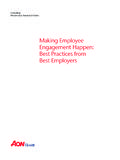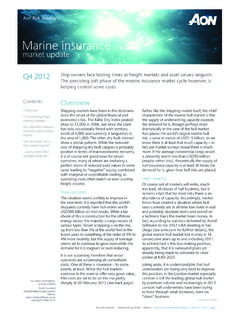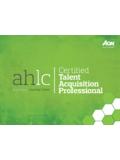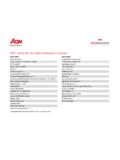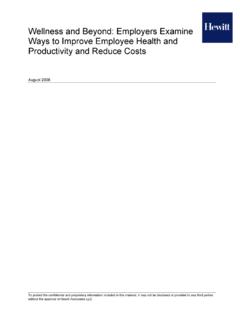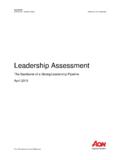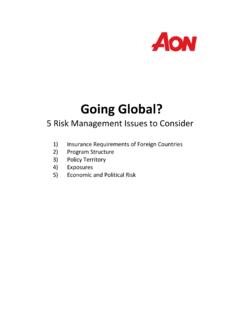Transcription of Solvency II: The captive guide to Pillar II - Aon
1 Aon Risk Solutions Global Risk Consulting Solvency II: The captive guide to Pillar II. Finding a way to formalise a fit-for-purpose and proportionate Governance and Risk Management System Contents Introduction 3. The Pillar II context 4. How to address it 7. A structured approach 8. It's all about consistency 9. Conclusions and Aon catalysts 10. 1 Solvency II: The captive guide to Pillar II Solvency II: The captive guide to Pillar II 2. Introduction The Pillar II context Initially the new regulatory requirements It should be noted, however, that Omnibus II discussions Supervisors have started to elevate the significance of Pillar II compliance are still in progress and that it is expected to be adopted by coming from the Solvency II Directive were the European Council and by the European Parliament in as a foundation block of Solvency II: firms under this new regulation will presented as the most significant threat the coming months only following the so called ex-ante need to put in place a governance framework with the processes and approach.
2 Indication of a postponement of implementation captive owners would ever have to face. controls in order to assess, manage and monitor their risks and related date to either 2015 or 2016 should be confirmed soon. A collapse of captive domiciles in the EU It is however our understanding that a number of Solvency assessment. was predicted based on various arguments member states are now pushing for a January 1, 2016. implementation date to ensure that industry has sufficient such as inadequacy between the underlying The Pillar II requirements are set out in nine articles [Exhibit 1] and time to prepare. purposes of the new regime and the captives' describe what an a ppropriate risk and governance system insurance and specificities; increased capital requirements; As the main European Union captive domicile, Luxembourg reinsurance undertakings will be required to implement.
3 Is obviously at the forefront of this working process and of uncontrollable and unmanageable governance the development of specific approaches to help captives on processes and higher management costs. their journey towards compliance. For example, the Luxemburg insurance regulator [Exhibit 1] A consistent set of articles From our perspective at Aon, all of these arguments missed a couple of crucial points, the main one being the (Commissariat aux Assurances, CAA ) has indicated that balancing act between the added value of a captive and calculations of the different Pillar I components of Solvency the weight of the extra workload introduced by Solvency II. II will be progressively introduced in the annual reporting requirements. So, what's the position a few years on? In Luxembourg and elsewhere, although there are still a lot of uncertainties to In particular the following requests have been issued: be tackled, it is fair to say that it has not resulted in mass In 2011, the completion of a table containing the Article 41.
4 Article 49. n captive shut down or exit to less demanding domiciles. Best Estimate of reserves based on 2010 accounts was General Governance Outsourcing There will inevitably be some that do, but from a global requested for all companies ; Requirements perspective the EU captive market has held up well and is working hard to achieve compliance with the Solvency II n In 2012, captive undertakings had to prepare a trial requirements. balance sheet compliant with Solvency II rules and perform the calculation of the Basic Solvency Capital Article 48 Article 42 &43. That said, this observation should not mask the lobbying Requirement ( BSCR ) ; Actuarial Function Fit &Proper efforts that still have to be undertaken by all captive market n In 2013, the CAA will be expecting calculations of Requirements stakeholders to ensure a more fit-for-purpose regulatory framework in areas of pillars 1 and 3.
5 The Risk Margin and of the total Solvency Capital Requirement ( SCR ) by adding the operational Pillar II. risk and adjustments for the loss absorbing effect Key articles pillars I and II are on track of technical provisions and deferred taxes to the BSCR. In addition, classification of own funds by tiers Article 47 Article 44. On January 19th 2011, the European Commission and determination of the level of eligible own funds Risk Management Internal Audit proposed the Omnibus II Directive, suggesting changes to will be required. the Solvency II Directive , including: n Describing the purpose and authority of EIOPA ; Similar request around SCR calculation, risk appetite statements, governance clarification, risk management and Article 46 Article 45. n Enabling the European Commission to ORSA have also been issued by regulators across Europe Internal Control Own Risk &.
6 Introduce transitional periods for specific areas ; Solvency Assessment including Ireland, Germany, Netherlands and Malta. n Postponing the implementation into national law. These initiatives are clearly aimed at having a well-prepared In the most recent Directive text, Member States are market. By increasing the focus on understanding, postponing national implementation to 31st March 2013 integrating and implementing the changes required, with enforceability as at 1st January 2014. Articles relating Solvency II has significantly changed the way (re)insurance to supervisory approval would then become effective from undertakings have to assess their risk and Solvency position. 1st July 2013 and regulated entities will need to provide their supervisors with an implementation plan providing However, one must keep in mind that the quantitative evidence of progress made by 1st July 2013.
7 Aspects of Solvency II are only one part of the challenge. Governance, risk management and reporting issues (as described in the second and third pillars ) must also be addressed. 3 Solvency II: The captive guide to Pillar II Solvency II: The captive guide to Pillar II 4. Taking each article individually: Article 41 Interdependencies between the risks will need to be taken Firms should perform this assessment regularly The actuarial function shall provide the Board at least General Governance Requirements into account. It should cover the risks included in the (at least once a year) and without any delay following annually a report which not only contains details of Firms will be required to have in place an effective calculation of the Solvency Capital Requirement ( Pillar I) as any significant change in their risk profile, for example : the appropriateness of the underlying methodologies, system of governance which provides for sound and well as the risks which are not or not fully included in the models and assumptions used in the calculation of n Changes to the business strategy.
8 Prudent management of the business. That system calculation thereof. technical provisions, but which enables the Board to judge shall at a minimum include a transparent organisational n Large losses during one fiscal year ; the impact and adequacy of the underwriting policy, structure with a clear allocation of responsibilities and The system should be documented, regularly reviewed reinsurance arrangements and the management of the n Shocks to the financial markets. segregation of duties, and an effective system for ensuring and fully integrated into the decision making process identified risks. the transmission of information across reporting lines. of the undertaking. Solvency II requires a specific Risk Management Function (RMF) to be in charge of ensuring All stages of the ORSA process shall be clearly documented, Article 49. Governance rules shall be documented, approved by the the risk management system remains suitable.
9 And independently peer reviewed. Outsourcing board and regularly reviewed (at least once a year). These requirements are directly related to articles 42 to 49 as Under Solvency II (re)insurance undertakings shall remain detailed in the following sections. For firms using a partial or full internal model, the risk This documentation must be made available to the fully responsible for discharging all of their obligations management function is responsible for the design, regulator. The ORSA is a new specific regulatory when they outsource functions or activities. implementation and validation of the model. requirement. It is therefore unsurprising that there will be The Principle of Proportionality enables firms to apply these a significant gap between current undertakings' readiness requirements in accordance with the size, nature and level All functions or activities can be outsourced, either Article 45 and this new Solvency II item.
10 Of complexity of their operations. internally (parent or sister company) and externally bearing Own Risk & Solvency Assessment (ORSA) in mind the Fit & Proper Requirements and the need Article 46. Articles 42 and 43 As part of its governance and risk management system for independence (Internal Audit). Only the mind and Internal Control Fit & Proper Requirements every (re)insurance undertaking shall conduct its own risk management of the company the Board of Directors and Solvency assessment that shall include at least: Insurance and reinsurance undertakings shall have in cannot be outsourced. Firms shall ensure that all persons who run the undertaking place an effective internal control system which should or have other key functions will fulfill the following The current and future Solvency needs taking into include at least: n requirements at all times: The supervisory authorities shall be notified prior to the account the specific risk profile, the business strategy Administrative and accounting procedures ; outsourcing of critical or important functions or activities Their professional qualifications, knowledge and and risk appetite of the firm as defined by the Board ; n as well as of any subsequent material developments with n experience are adequate to enable sound and n The compliance, on a continuous basis, with the n Compliance with the law ; respect to those functions or activities.
